Erin. Author of wlw novella, Truth Weekend, available on Amazon. Here to explore the pitfalls and euphoria of creation. I will also be reblogging Truth Weekend Cinematography inspo as I am writing the screenplay now. Talk to me!
Don't wanna be here? Send us removal request.
Text
The Secret To Writing Shippable Romances, Part 2!

The secret to writing a shippable romance that we actually care about is through character flaws. We talked about why that’s so important and the easiest way to execute this in part one, but my favorite way to use flaws in a romance is by making a character’s flaw a reaction to an insecurity they have.
Types of insecurities:
Physical/ body image
Intellectual
Looking cringey / like a “try hard”
Lack of competency/ the ability to accomplish one’s goals
No one likes them
Financial
Lack of success/ recognition/ awards
Lack of experience
Lack of strong relationships/ healthy support system
Now let’s put the above into practice by using intellect as an insecurity.
Example A: A character is insecure about their intellect and they react to this by playing dumb. Their flaws could manifest as them not having high expectations for themselves, telling self-deprecating jokes about how stupid they are, staying silent even if they know the correct answer, or doubting that they know the correct answer. They may also think their ideas sound dumb and fear they will be ridiculed for their ideas, so they never share them. This character is always playing small and accepting crumbs in all areas of life, including romance.
People like this typically don’t emphasize their intellect in relationships. Some may downplay their intelligence (or even mock it) to appeal to the other person and emphasize other qualities—beauty, sensuality, dependability, spontaneity, a favorable power dynamic, social status, humor, compassion, etc. They don’t allow people to get that close to them, because that would inevitably reveal their self-perceived lack of intelligence.
Writing prompt: With this insecurity, reaction, and flaw, what type of partners has your character attracted in the past? How did your character feel and operate in these relationships?
How I would do it: If I were writing a romance with a lead character who was insecure about their intelligence, I would give them a history of purposefully picking partners that won’t intellectually challenge them even though that is something they crave. They want to be intellectually stimulated by their partner. They want to have nuanced conversations about complex topics, but they are afraid that if they initiate or engage in these conversations, the other person will see them as less intelligent, thus making them easier to manipulate, which is a fear of theirs.
Due to not being intellectually stimulated by their partner, our character gets bored in relationships and reacts by creating drama in other areas of the relationship to keep it exciting, but this ultimately pushes their partners away. This is the cycle that our character has been stuck in, but what happens when they meet someone new that they really like, but will challenge them intellectually? Are they going to react differently this time? Are they going to stumble towards change in a messy, yet entraining way, and relapse? Sounds like an interesting plot to me!
Remember, we’re choosing collective components that are conducive to the unfolding plot and desired character arcs, so if you’re fascinated by intellect as an insecurity, but “playing dumb” isn’t in alignment with your character’s personality, then you would choose a different reaction.
Example B: A character is insecure about their intellect, but their reaction is to overcompensate by tearing others down. They’re an obnoxious know-it-all and they have to be right about everything. Their flaws manifest as them purposefully making others look dumb and publicly discrediting their intelligence. If you are an expert in a topic, this character will argue that you aren’t and try to explain the basic principles of this topic to you even though they know very little about the subject. They must prove that they’re smarter than you, so they quiz you on things that any adult human would know and always speak in a condescending tone.
A person like this typically has a deep shame around being wrong/ vulnerable and doesn’t let people get close to them because they fear others will be able to see through their arrogant façade and use their vulnerabilities to hurt them.
Writing prompts: What kind of partners do you think this character would attract? How have their relationships worked out for them in the past? What typically ends their relationship? What happened to them in the past that made them put up these walls? Where does this insecurity stem from? What is a core belief about themselves that made them act this way? How does this play out in love?
A character’s insecurities will cause them to run into the same toxic relationships and patterns until they decide to change. However, they can only change once they shift their core beliefs about themselves and love.
If you don’t know what a character’s core beliefs are, their insecurities, where they stem from and how to weave them into your plot, then check out the digital Character Backstory Workbook with over 100 questions and exercises so that you can write your juiciest romance yet!
If you want to read the most exciting way that you can incorporate flaws into your romance then like and comment for part 3. Happy writing!
Read my wlw novella, Truth Weekend!
Character Backstory Workbook
#writblr#screenwriting#writing#creative writing#screenplay#novel writing#nanowrimo#book writing#writers on tumblr#writing inspiration#writing romance#romance#romance books#romance writing#romance novels#dark romance#soulmates#shipping#national novel writing month#book outline#artists on tumblr#oc#original character#writing community#writing prompt#writing advice#writing ideas#on writing#writing life#writer
15 notes
·
View notes
Text
WRITING ROMANCE: The Secret To Writing Shipable Characters Part 1

The SECRET to writing shipable romances that we actually care about is by giving your characters flaws that are conducive to the plot and their character development.
Interesting and well-thought-out flaws make your characters interesting and complex, which makes us more invested in them, which makes us more invested in their relationships, which makes us want to see if they are going to screw up their relationships because of their flaws. Giving your characters inner issues that they need to work through builds tension, raises the stakes, and gives a compelling reason why your protagonist and love interest can’t just be together on page 5.
So how do we do this? There are three big ways, but the EASIEST way is to explore the negative or extreme side of a character’s positive traits.
The best thing about you could also be the worst thing about you. Think about your friends, family, and yourself. Oftentimes, your strength is your weakness.
Example 1: Your character is a hard worker, but they constantly state that they only feel happy when they are working. They feel inclined to work 24/7 to maintain their lifestyle or achieve their dreams at all costs, thus neglecting their mental health, family, friends, and potential partners.
This character’s arc could likely include:
· Not measuring their desirability/ ability to be loved by how successful they are.
· Finding pleasure outside of work.
· Not ghosting people for work.
· Finding a healthy work-life balance.
· Finding a partner that is also passionate about their work and is supportive.
Example 2: A character is exceptionally kind and optimistic, but their flaw is that they are too forgiving and can be naïve and easily manipulated.
How this could play out romantically:
· They are too forgiving of partners treating them poorly.
· They completely ignore red flags.
· They’re a people pleaser.
· They don’t want to ruffle feathers by saying that something upset them or inconvenienced them.
· They’re afraid that if they speak up, then the relationship will end.
· They have a pattern of staying in unfulfilling relationships.
Let me know if you want to see the other 2 ways that you can incorporate flaws into your romance!
All of this is just the tip of the iceberg when writing romance, so if you want to learn more ways to mine these flaws from your character’s backstory and how to weave them into the plot and character reactions, then check out The Character Backstory Workbook. It has over 100 questions that will help you craft your best romance yet! Happy writing!
To read my wlw novella, Truth Weekend click here.
#writblr#screenwriting#writing#creative writing#screenplay#novel writing#nanowrimo#book writing#writers on tumblr#writing inspiration#romance writing#writer community#spilled ink#spilled words#romance books#romance novels#character flaws#writing tips#writing tool#writing tropes#writing advice#writing a book#writing aesthetic#writing about writing#writers of tumblr#literature#wlw books#wlw yearning#writing template#character building
14 notes
·
View notes
Text
Create 3-Dimensional Characters!
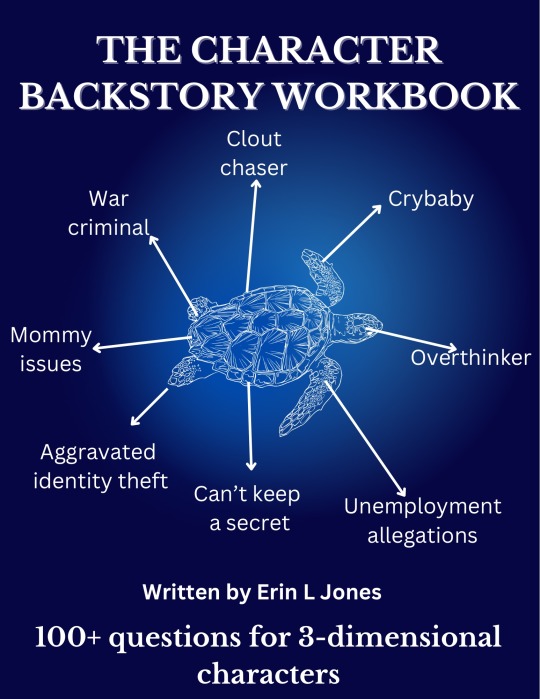
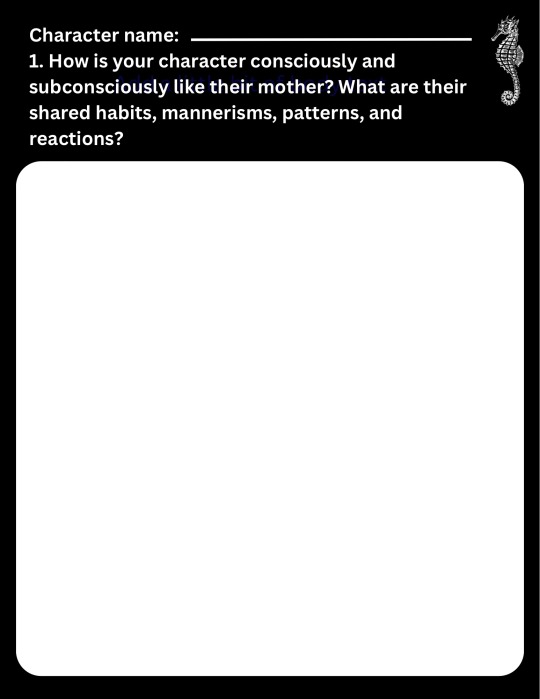

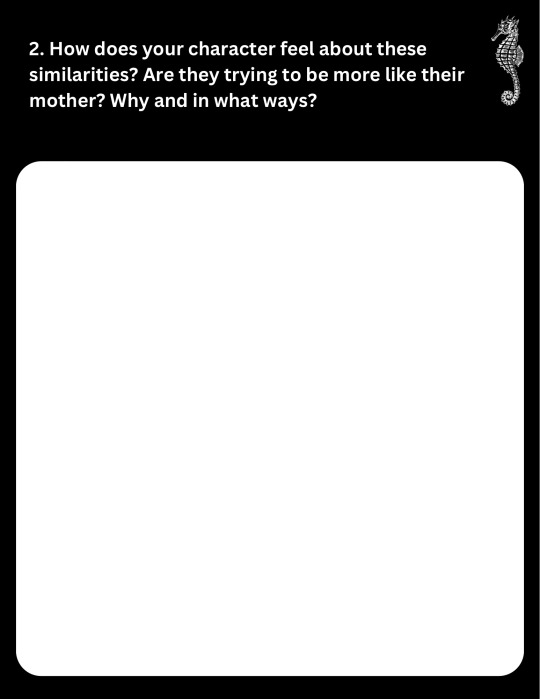
After years of using character profile templates and being frustrated by the fact that there is never enough room to write and that the questions didn’t go deep enough, I created The Character Backstory Workbook! As an author who knows that readers come for the plot, but stay for compelling characters, I set out to create a tool for writers who want to craft 3-dimensional characters that readers could have an emotional investment in and know like their best friend. Asking what a character’s hair color is isn’t “unhelpful,” but most writers need questions that trigger their imagination.
This 100+ question digital download (or you could print it out) includes:
• A family history deep-dive
• A closer look into your character’s childhood
• Explores their platonic and romantic relationships (past and present).
• Examines their goals, desires, fears, flaws, strengths, and how they transform the plot! + more
This book will spark ideas and build character arcs that raise the stakes in your plot! Grab a copy and get to writing ♥️
#writers on tumblr#writers of tumblr#creative writing#artists on tumblr#dark academia#cottagecore#novel writing#writblr#screenwriting#writing#screenplay#nanowrimo#book writing#book outline#romance writing#writing prompt#writing community#writing inspiration#writing advice#writing tips
12 notes
·
View notes
Text
Writing Tips: How To Spot A 1-Dimensional character!

Are your characters missing any of the above elements? If you don’t know to craft 3-dimensional characters with traits informed by their backstory and add complexity your plot, get The Character Backstory Workbook! It has over 100 questions to help you flesh out each of your characters and their arcs!!
#writers on tumblr#writers of tumblr#creative writing#artists on tumblr#writblr#screenwriting#writing#screenplay#novel writing#nanowrimo#book writing#art#romance writing#on writing#writers block#writerscommunity#writing template#writing tools#writing prompt#writing inspiration#writing advice#writing tips#character profile#character design#character concept#character building
9 notes
·
View notes
Text
Character Development Tips!
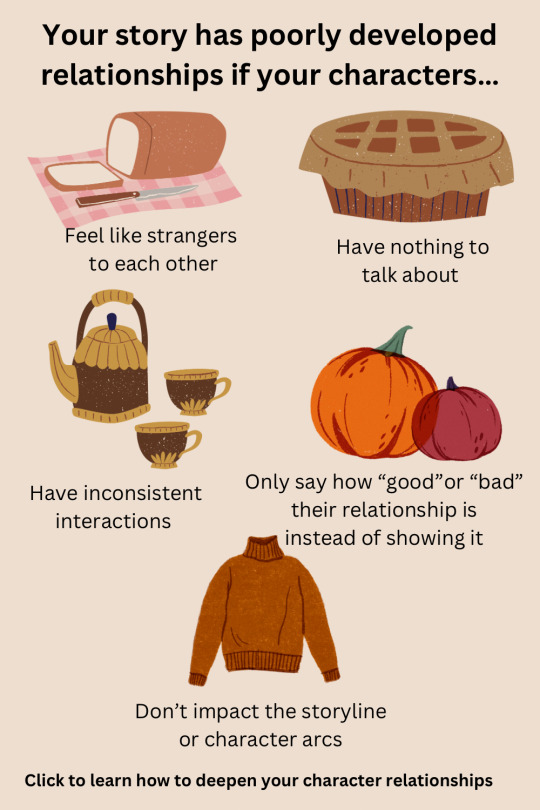
To learn how to avoid the above and create 3-dimensional characters with interesting backstories that inform their interactions with other characters, click here to get The Character Backstory Workbook!
#writblr#screenwriting#writing#creative writing#book writing#nanowrimo#screenplay#novel writing#writers on tumblr#romance writing#on writing#writing template#writerscommunity#writers and poets#writing prompt#writing advice#writing tips#writing inspiration#writing community#writing tools#character bio#original character#character design#dnd character#character development#character building#character design sheet#character profile#character moodboard#character backstory
67 notes
·
View notes
Text
Thank you Diane Keaton!
Daydreaming about Diane Keaton is what lead me to writing my chaotic little wlw novella!
Click here to read Truth Weekend!
#wlw books#wlw#sapphic#enemies to lovers#novel writing#writblr#writing#book writing#writers on tumblr#creative writing#romance#romance books#book recommendations
1 note
·
View note
Text
Click here for The Character Backstory Workbook! Over 60 pages and 100+ prompts for creating 3-dimensional characters that inspire interesting plot points 💕
#writblr#screenwriting#writing#screenplay#creative writing#novel writing#book writing#nanowrimo#writers on tumblr#book outline#bookblr#writerscommunity#romance writing#on writingw#writers block#writing template#character building#character design
2 notes
·
View notes
Text
If you have a lot of creative ideas/ story ideas swirling around in your head then a Creative Bucket List is the way to go!
Click here for The Character Backstory Workbook! Over 60 pages and 100+ questions for crafting 3-dimensional characters that inspire interesting plot points ♥️
#writblr#screenwriting#writing#screenplay#creative writing#novel writing#youtube#book writing#writers on tumblr#nanowrimo#literature#writing tips#writing advice#writing tools#plotting#writing help#creative
1 note
·
View note
Text
Your maladaptive daydream is probably someone’s comfort novel!
Click here for the character backstory workbook! Over 60 pages and 100+ questions for crafting 3-dimensional characters that inspire interesting plot points 💕
#writblr#screenwriting#writing#screenplay#creative writing#novel writing#nanowrimo#book writing#writers on tumblr#literature#character building#original character#writing wip#wip wednesday#writing template#writing tips
1 note
·
View note
Text
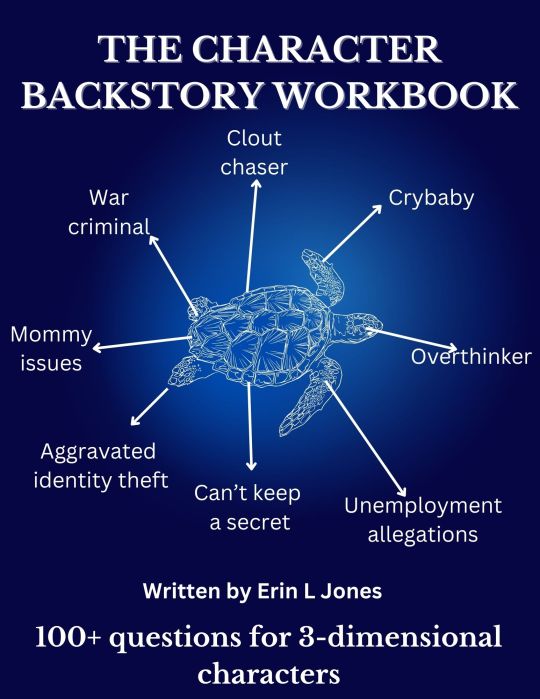
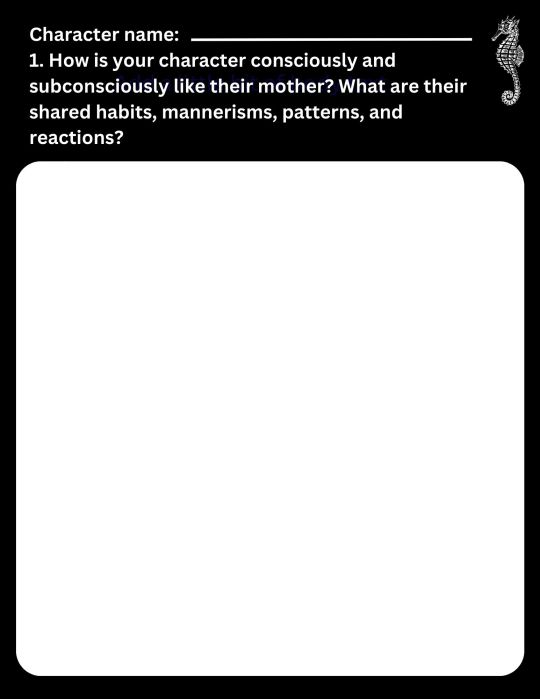
WE LOVE A CHAOTIC COVER!
Welcome to The Character Backstory Workbook. In this workbook you will be given the space, figuratively and literally, to build 3-dimensional characters that you know like the back of your hand. This book will spark ideas, answer tough questions, and (for some of you) fill plot holes. Most people cannot create a character with a simple template that asks you what your character’s eye color is. Thankfully, this book goes much deeper with over 60 pages and 100+ questions.
Workbook contains:
• A family history deep-dive
• A closer look into your character’s childhood
• Explores their platonic, familial, and romantic relationships (past and present)
• Examines their goals, desires, fears, flaws, strengths, and more!
Click here for the workbook
#writing#writblr#screenwriting#writers block#character design#writing resources#writing tools#writing advice#writing reference#writing tips#writerscommunity#writers on tumblr#creative writing#writerslife#original character#literature#spilled ink#scriptwriting#screenplay#fanfiction#book outline#bookblr#book writing#novel editing#novel writing
9 notes
·
View notes
Text
The Character Backstory Workbook is here!
This is for writers who love character profile templates but hate that they don't give you enough room to write and you want to do psychological deep dives on your characters. Also, I'm using Rosie from my novella Truth Weekend in this video as an example.
Click here for the workbook.
Click here to watch the full YouTube video!
#writblr#screenwriting#writing#writers block#writers on tumblr#writers and poets#writerscommunity#creative writing#writerslife#writing resources#writing reference#writing romance#ocs#original character#character profile#book outline#writing template#writing techniques#writing inspiration#novel writing#on writing#writing prompt#writing process#literature#words
5 notes
·
View notes
Text
youtube
Create A Character With Me!
In this video, I do a page from my Character Backstory Workbook so grab one of your OCs (preferably one with horrifying mommy issues) and come on in!!
#writblr#screenwriting#writing#nanowrimo#second drafts#book writing#bookblr#my ocs#book outline#character template#writing resources#writing romance#creative writing#on writing#writers block#writing tips#writing tools#writing motivation#writing advice#romance writing#notion#Youtube
2 notes
·
View notes
Text
Aesthetics With Erin Part 1: How a story’s theme(s) can transform an aesthetic
If you’d rather watch my miniature video essay on this then click here.
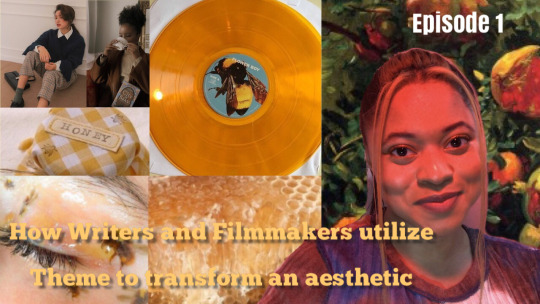
The exact science of building an aesthetic
When building an aesthetic, it is imperative to examine: the tone of your story, the feelings you want to create in your audience, and what types of settings, clothing, objects, and colors convey that.
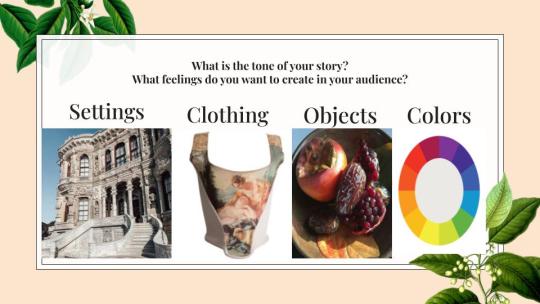
An easy place to start with this is your story’s theme.
According to the young prophet’s guide (also known as Wikipedia): In contemporary literary studies, a theme is a central topic, subject, or message within a narrative. Themes can be divided into two categories: a work’s thematic concept is what readers “think the work is about” and its thematic statement being “what the work says about the subject.”
The dissection
Now let’s look at the themes and aesthetics in the internet’s current hyper-fixation: Cottage-core.
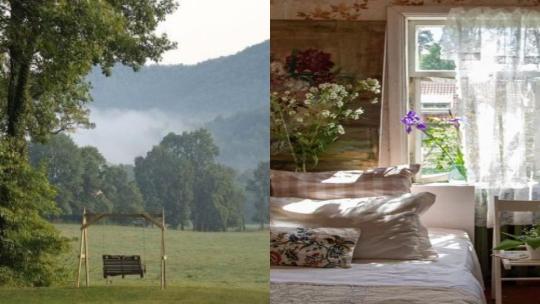

According to Aesthetics.fandom.com, Cottagecore (also known under the name Farmcore or Countrycore) is an aesthetic inspired by a romanticized interpretation of western agricultural life. It is centered on ideas around a more simple life and harmony with nature. Certain themes associated are the survival of the environment, food, and caring for people.
My favorite example, especially if we’re taking finances into account, is Ms. Honey from Matilda. Greta Gerwig’s Little Women adaptation is also a wonderful addition.
Common cottage-core themes are:
Solitude and isolation
Rejection of modern ways of living
Finding warmth and safety in femininity
The desire to escape
Romanticizing a simpler life
Connection with nature
Sometimes the idea of purity, innocence, or connecting with one’s inner child
And often times gay yearning. Gay adjacent yearning, curious yearning, forbidden yearning, forbidden yearning that turns into can’t resist yearning, and not necessarily yearning but if the opportunity presented itself… we could adjust said yearning accordingly.
While your character’s personal aesthetic does not have to be an offshoot of your story’s aesthetic—i.e. the movies and TV shows where we have the friend group with the preppy one, the sporty one, and the e-girl—each character can have their own aesthetic and exist within a larger one.
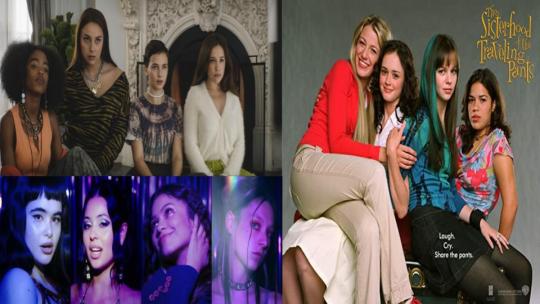
However, if your story or character doesn’t deal with say cottage core themes, it wouldn’t make sense to use this aesthetic (though of course do whatever feels right to you) unless the contrast in theme and aesthetic, heightens and transforms the narrative.
A great example of this transformation is Ari Aster’s Midsommar, a horror psychological drama with themes of deceit and betrayal. This film uses our expectation that horror lives in the dark against us by setting the most disturbing scenes in broad daylight with aesthetics that typically symbolize purity, childlike innocence, freedom, and safety.
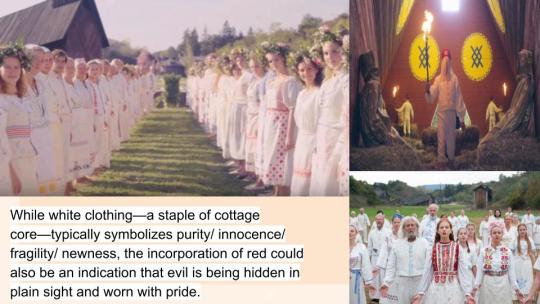
This is further exacerbated by the juxtaposition between the dreary color pallet that corresponds with Dani and Christian’s failing relationship/ the all-consuming personal tragedies in Dani’s life in the first act and the lush greens and flowers that symbolize good fortune and celebration in the following acts. This visual betrayal and contrast transforms the original aesthetic and now not only makes it unsettling, but unreliable. Thus, creating suspense. It’s brilliant and I’m jealous.
Alright guys, that was part one. Part two will be much longer and very niche and nerdy, but at this point, that’s just my brand. Happy writing!
23 notes
·
View notes
Text
Aesthetics With Erin Part 1: How a story’s theme(s) can transform an aesthetic
If you’d rather watch my miniature video essay on this then click here.

The exact science of building an aesthetic
When building an aesthetic, it is imperative to examine: the tone of your story, the feelings you want to create in your audience, and what types of settings, clothing, objects, and colors convey that.

An easy place to start with this is your story’s theme.
According to the young prophet’s guide (also known as Wikipedia): In contemporary literary studies, a theme is a central topic, subject, or message within a narrative. Themes can be divided into two categories: a work's thematic concept is what readers "think the work is about" and its thematic statement being "what the work says about the subject."
The dissection
Now let’s look at the themes and aesthetics in the internet’s current hyper-fixation: Cottage-core.


According to Aesthetics.fandom.com, Cottagecore (also known under the name Farmcore or Countrycore) is an aesthetic inspired by a romanticized interpretation of western agricultural life. It is centered on ideas around a more simple life and harmony with nature. Certain themes associated are the survival of the environment, food, and caring for people.
My favorite example, especially if we’re taking finances into account, is Ms. Honey from Matilda. Greta Gerwig’s Little Women adaptation is also a wonderful addition.
Common cottage-core themes are:
Solitude and isolation
Rejection of modern ways of living
Finding warmth and safety in femininity
The desire to escape
Romanticizing a simpler life
Connection with nature
Sometimes the idea of purity, innocence, or connecting with one’s inner child
And often times gay yearning. Gay adjacent yearning, curious yearning, forbidden yearning, forbidden yearning that turns into can’t resist yearning, and not necessarily yearning but if the opportunity presented itself… we could adjust said yearning accordingly.
While your character’s personal aesthetic does not have to be an offshoot of your story’s aesthetic—i.e. the movies and TV shows where we have the friend group with the preppy one, the sporty one, and the e-girl—each character can have their own aesthetic and exist within a larger one.

However, if your story or character doesn’t deal with say cottage core themes, it wouldn’t make sense to use this aesthetic (though of course do whatever feels right to you) unless the contrast in theme and aesthetic, heightens and transforms the narrative.
A great example of this transformation is Ari Aster’s Midsommar, a horror psychological drama with themes of deceit and betrayal. This film uses our expectation that horror lives in the dark against us by setting the most disturbing scenes in broad daylight with aesthetics that typically symbolize purity, childlike innocence, freedom, and safety.

This is further exacerbated by the juxtaposition between the dreary color pallet that corresponds with Dani and Christian’s failing relationship/ the all-consuming personal tragedies in Dani’s life in the first act and the lush greens and flowers that symbolize good fortune and celebration in the following acts. This visual betrayal and contrast transforms the original aesthetic and now not only makes it unsettling, but unreliable. Thus, creating suspense. It’s brilliant and I’m jealous.
Alright guys, that was part one. Part two will be much longer and very niche and nerdy, but at this point, that’s just my brand. Happy writing!
#writing#writblr#writeblr#cottagecore#farmcore#countrycore#nanowrimo#film analysis#literature#literature analysis#academia aesthetic#aesthetic#film#creative writing#screenplay#screenwriting#book writing#novel writing
23 notes
·
View notes
Note
hi! just wanted to say you give great advice!!
Hi, not sure why this made me emotional, but thank you!! I'm glad you find it helpful.
Also, to everyone who contacted me through tumblr messenger asking to share my Writing Fictional Towns post on their site or Insta with credit, thank you! I wasn't ignoring you. I lost the password for this tumblr, but I'm back! Feel free to ask away.
3 notes
·
View notes
Video
It’s me! Making a text post on this with photos soon. Yay!!
youtube
The Exact Science Of Creating Aesthetics | Aesthetics With Erin Episode 1
In this bite sized video/ picture essay I will QUICKLY (like a knife fight in a phone booth) unpack why Theme is the backbone of creating an aesthetic for your story and characters. It’s a hoot and the introduction to a series of much longer and nerdier videos on character creation using aesthetics. I hope you like it! Episode 2 will be in a different style but just as chaotic. Tell me your thoughts :)
PS. I haven’t published a writing video in over a year and I’m nervous.
#I'm back!#Can you tell it's been a minute since I posted here#so much has happened but I feel so inspired
44 notes
·
View notes
Text
Writing A Fictional Town | Tips & Tricks
When we talk about world building, we usually think of scifi or fantasy stories where we have to create languages and build magic systems that somehow explain why gravity is upside down or why the walls chant an ancient language that you can only decipher at the witching hour. But what if you just want to create a bizarre little town to set the scene for your story? I did it for Truth Weekend!
Here are 3 steps to creating your own town. Or if you’d rather watch my video on this, click here.
Step 1: Nail down an appropriate name.
Are you an author aiming for premium chaos like Riverdale or a deceitfully happy name like Sunnybrook, when really there’s sinister activity below the surface? Maybe that has something to do with the hero or villain that got to name the town.
For example, there’s this neighborhood in sunny sleepy Florida called Champaign Lane that consists of middle middle/ lower middle income young people who just got out of college and are renting their first homes. Though it is in a part of town with minimal resources, all the little houses are a gorgeous pale pink or turquoise with white roofs and immaculate yards, so while I find the name to be ironic, I also view it as a goal. The residents are hungry and ambitious youth, hustling to make their dreams come true so that they can get to a place in life where they’re popping champagne. This also poses an allegory for living behind a familiar facade of having lots of money and happiness when really we don’t. The hidden juxtaposition adds an extra layer to your setting and you didn’t even have to do that much.
Step 2: What are all the secrets and sins of the town?
What are the legends of the lake? What streets are for daylight only? Who is the woman in the window you’re told stay away from?
Recently, I was reading an idealistic romance set in a fake town in California with a scene in a grocery store where a character looks at a missing child flyer and says, “It’s a shame this family can’t catch a break. Her sister literally drowned in Lake Eerie three months ago.” A small moment like that adds so much texture and validity to the scene and suddenly the thing on the page is alive again.
So if you’re looking for a nifty little writing exercise, then I’d say write up three myths or legends about the places and people of your town. Bonus points if there’s a story about the crooked family on the tallest hill.
Step 3: Define the details of what makes your town so special.
What are the oddities and marvels of this place that are so distinct that you couldn’t set it in a real town or a real neighborhood? I like to separate this stage of planning into three parts: color, aesthetic, & monuments.
Color Theory.
For me, a fun way to get the wheels turning when world building is to create a color pallet. In the opening of Truth Weekend, the colors in Skye’s world are quite muted and grungy, but when we meet Rosie there’s a rush of blood with plums, burgundies, wine red, and amber. And now the whole scene has a heartbeat.
As they enter this new world together, the previous colors become more vibrant. Bold. It’s not just blue, its cobalt and if its red, its neon. It’s like the saturation is cranked all the way to 100 to reflect the emotional intensity and how uncomfortable, yet cathartic this situation is. As their relationship changes, we then get into the lavenders, the magentas, and the concept of yellow which poses a fitting dichotomy in its dual meaning of rebirth and cowardice. Use color theory to you advantage! The symbolism writes itself.
Next, the Aesthetic.
This lets you hone in on your unique style, voice, and vision while having a touch stone to come back to.
Are we going for a Florida Gothic aesthetic where we have an orange field on one side of the road and we have a marble cherub in front of a Waffle House on the other side? I once saw a motel sign where the tagline read: stay for a while… stay forever. This creep-fest feeds into that well-meaning, but unhinged Midwestern Gothic of cornfields, dirt roads, and rumors of three eyed blood deer.
Exercise: look up some aesthetic (regional, occupational, academic, etc.) photos or Pinterest boards that fit your story and make a list of interesting things that you could put in your town. Here’s mine: sunny-side-up wall paper, the Oasis motel, conspiracy theory diner, rainbow slushies, cannabis cookie shop, a yellow house shaped like a boot, an iguana eating hydrangeas in a sunflower field, crop circle picnics, and a bookstore built for an acid trip.
Don’t be afraid to include wild life, nature, and peculiar architecture within this list. However, if your creative genius mind doesn’t jive with aesthetics, we still have monuments. You know… the best part of this whole thing.
Monuments: What are the key locations that are only in this town?
What are the hot spots of the town? Where do the old people hang out? Is the town covered in graffiti or is it posh? Maybe it is abnormally homogeneous. Is there a mansion next to a trailer park or a prison next to a school?
Exercise: create 10 unique locations. Why ten? Because it’s a good number, but you can always expand it. Create 10 locations and watch your dream town that is so full of character and foreshadowing unfold in front of you.
Alright guys, that’s all that I have for you today. I hope this got the creative juices rolling. Comment down below and let me know any more hyper-specific topics you want me to hit on. Happy writing!
7K notes
·
View notes